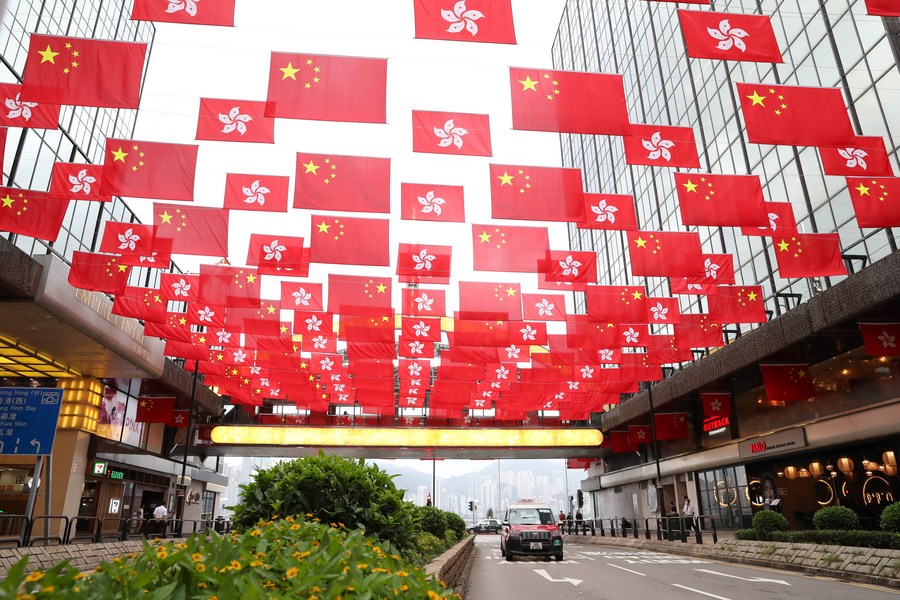Qianhai can help HK boost development


Since its establishment in 2010, the Qianhai Shenzhen-Hong Kong Modern Service Industry Cooperation Zone has made great progress. To begin with, it has transformed from a mud flat into a modern, highly developed commercial zone with more than 10,000 Hong Kong enterprises.
On Sept 6, Beijing released a new plan to comprehensively deepen reform and opening-up in the cooperation zone, according to which the Qianhai zone's area will be expanded from 14.92 square kilometers to 120.56 sq km. With increasing cooperation between Shenzhen and Hong Kong on the industry and market fronts, and Qianhai's innovation-driven development pattern, the cooperation zone will be developed into a testing ground for in-depth reform and higher-level opening-up.
The Qianhai project will significantly boost Hong Kong's economic growth, deepen cooperation between Guangdong province and the Hong Kong and Macao special administrative regions, and further promote opening-up. It will also help expedite the development of the Guangdong-Hong Kong-Macao Greater Bay Area, make Shenzhen a better demonstration of socialism with Chinese characteristics, and instill in Hong Kong residents a greater sense of belonging to the motherland.
As normalcy returns to Hong Kong after the almost yearlong mayhem committed by the subversives in 2019 and the COVID-19 pandemic after that, the first priority of the SAR should be to spur economic growth and improve people's livelihoods, as well as solve the problems of housing, employment and social mobility, which the younger generation cares most about. And the new Qianhai development plan can help Hong Kong better address these problems.
The fact that the central government has released the new plan now shows it is committed to supporting Hong Kong to attain higher levels of growth and prosperity.
The turmoil in Hong Kong in 2019 revealed that the widening wealth gap is a major cause of growing anxiety among the city's youths. The Gini coefficient of Hong Kong rose from 0.43 in 1971 to 0.54 in 2016. Worse, more than 1 million of the about 7.4 million residents of Hong Kong are poor, making the city among the world's most unequal societies.
These problems have long plagued Hong Kong, especially because it is difficult for it to clear some of the development bottlenecks. With a land area of only 1,106 sq km and a population of 7.4 million people, Hong Kong has a relatively small market and limited economy of scale. The COVID-19 pandemic laid bare this weakness, because it reduced exchanges between the SAR and the Chinese mainland.
Also, Hong Kong has an unbalanced industrial structure, as its service sector accounts for 93 percent of its GDP while almost all its manufacturing units have shifted to the mainland and other regions. In addition, the almost yearlong riots followed by the debilitating impacts of pandemic have dealt a severe blow to the city's pillar industries such as trade, logistics, tourism and retail. As a result, from being the second-largest sector, the financial industry has become the largest sector driving Hong Kong's economy. And the fact that despite contributing about 20 percent of GDP, it creates merely 5.5 percent of the jobs has further widened the income gap in the city.
On the other hand, the high-tech industry is the largest sector in Shenzhen-it accounts for one-third of the city's GDP. And the city is home to leading global companies such as Huawei, Tencent, BYD, and ZTE. Finance is the second-strongest pillar of Shenzhen, accounting for about 14 percent of GDP. As for Guangzhou, capital of Guangdong province, its top three industries are electronics, automobile manufacturing and petrochemicals. Finance is the fourth-largest sector, accounting for less than 10 percent of its GDP.
Due to the absence of high-tech industries and advanced manufacturing, Hong Kong has an unbalanced industrial structure, which has contributed to the widening wealth gap. And since Hong Kong lacks high-tech and manufacturing industries, it has not benefited from the opportunities created by the mainland or other economies to boost its growth.
But it can benefit from the Qianhai project. By integrating into the Greater Bay Area, helping create a single, composite China market, and facilitating the free flow of production factors across borders, the SAR can clear the bottlenecks obstructing its economic growth.
The expansion of Qianhai will further deepen Shenzhen-Hong Kong cooperation on several fronts including industry. That Qianhai will connect with other cooperation zones in the Greater Bay Area and is geographically close to Hong Kong means it can facilitate Hong Kong's integration into the country's economy.
Besides, the inclusion of logistics, marine, high-tech, and convention and exhibition industries in the expanded Qianhai cooperation zone will promote closer collaboration between Shenzhen and Hong Kong in these fields. For instance, Hong Kong which has an edge in the shipping business and Shenzhen that has an advantage in the logistics industry can complement each other. Shenzhen can learn from Hong Kong the nitty-gritty as well as nuances of how to hold high-level global conventions and exhibitions, and become a global aviation hub.
The expansion of Qianhai will also strengthen "one country, two systems" by helping Hong Kong further integrate into country's economy and boost the Greater Bay Area.
From a small fishing village in 1978, Shenzhen has become a metropolis of global repute. And its GDP, from just 0.2 percent that of the SAR in 1978, has overtaken it in a little more than 40 years.
Apart from the service industry, Shenzhen also leads the country in technological innovation. In 2019, Shenzhen's investment in R&D accounted for 4.9 percent of its GDP(132.8 billion yuan-$20.57 billion), far exceeding the 0.86 percent of Hong Kong. And with more than the country's one-third of international patent applications, Shenzhen has ranked top in the country for 16 consecutive years.
The central government has high hopes of Hong Kong as it has expanded the Qianhai zone in an attempt to include more Hong Kong residents from all walks of life in the regional development plan and to help the two sides to work together in the fields of technology, services and green finance.
Beijing's deepening of reform and opening-up should make Hong Kong realize that it is losing its prime position as the link between the mainland and the West and, therefore, should play a bigger role in other areas including the Greater Bay Area, the "dual circulation" development paradigm, the Belt and Road Initiative, and the efforts to build a community with a shared future for mankind.
If it doesn't seize these opportunities, Hong Kong, from being a pioneering city in many respects, could be left behind in the global development race. As a global financial, trade and shipping hub, the SAR still has a big role to play in Sino-foreign exchanges and the service industry. And by becoming a key part of the Greater Bay Area, it can maintain its competitive edge and by leveraging the advantages of the two sides, it can become a global innovation center in high-tech. Which would enable both Hong Kong and the mainland to share the benefits of growth.
The author is director at the Institute of Studies for the Guangdong-Hong Kong-Macao Greater Bay Area, Guangdong University of Foreign Studies.
The views don't necessarily represent those of China Daily.
If you have a specific expertise, or would like to share your thought about our stories, then send us your writings at opinion@chinadaily.com.cn, and comment@chinadaily.com.cn.
































